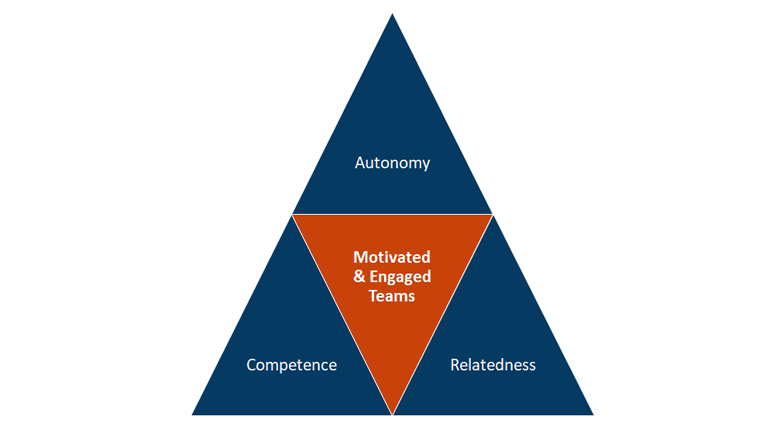Build a stronger, more resilient team
3 keys to battle burnout, retain employees, and drive improved performance
- If your team can find their own “why” for doing things, they’ll meet the goal every time.
- Employees crave the confidence that comes with competence. Legacy tools and outdated training methods don’t help with this.
- Improving autonomy and competency provides room for people to worry less about themselves and more for their teammates, the work their doing, and the customers they’re doing it for.

In 1967, Dick Proenneke1 retired at age 50 and moved to the Aleutian Peninsula in Alaska to live a simpler life. On his own, using little more than a few hand tools, and whatever nature had to offer, he built a log cabin. It wasn’t just a ramshackle building that could shelter him from the elements. It was a comfortable home that he would live in for several decades.
When he was done, his cabin had a split door on wood hinges with a locking mechanism to keep out bears. There was a big window facing the lake and a stone chimney chinked with clay. He dug a cooler into the permafrost to keep food fresh through the summer months. And he built an 11-foot-tall cache to store other food (bears again). Dick made his own furniture, kitchen utensils, snow shovel, berry picker, and other things he needed. Oh, and he also filmed himself doing all of this.
After 30 years, when he was 82 and couldn’t manage the workload anymore, Dick moved in with his brother in California. There he spent the remaining years of his life, only visiting the cabin once more before he passed.
By his own account, Dick Proenneke lived a content and meaningful life. It wasn’t because he had attained what we typically think of as basic needs: food, water, shelter, and security. It was because he had the things that make humans fulfilled.
He lived autonomously, receiving limited resources from the outside world. He was competent and confident in his ability to build what he needed and provide for himself. And he shared a balanced relationship with the wilderness getting what he needed, but never taking more than that.
These three basic needs – autonomy, competence, and relatedness2 – are what make us human. It’s what gets us out of bed in the morning and helps us thrive instead of just survive.
In business, many leaders focus on cash-based incentives, ensuring their teams’ survival needs. This is important, of course. But if you stop there, you’re missing an important opportunity.
Providing an environment where your teams can flourish will help you tackle some of your thorniest challenges like burnout, engagement, retention, innovation, and performance.
Motivation through Autonomy

Even the best coaches can struggle to motivate their teams. Motivation is a very personal thing. There’s little you can say to someone, much less a group of people, that will motivate them to perform better.3 But, if they can “find their own why” for doing things, they’ll meet the goal every time.
This probably sounds a bit squishy, until you recognize that people ultimately make their own choices no matter what you do. No amount of reminding, cajoling, or threatening will change that.
Autonomy is an ingrained desire to control your own life. It doesn’t mean being independent of the rest of the team, just having the ability to work freely toward a goal within constraints.4, 5 Autonomous employees drive themselves and respond well under pressure, particularly when the unexpected happens.
Your job is to provide enough transparency on goals and constraints to provide a healthy balance of autonomy and accountability for your team members.
Whatever the goal is, put a label on it, even better, put a number on it. Share that with your team and make sure everyone understands what it is and how to track it. Also, make sure they understand why it’s important to them, the customer, and the company.
Then identify the guardrails. Regulations, safety policies, deadlines, production goals, or procedures that ensure quality – all of these are reasonable constraints. When your team understands them, you’ll get better compliance on constraints too.
One of the biggest fears leaders have about providing their teams autonomy is their insecurity in their teams’ competence. That’s another critical need for your team’s morale and for their ability to get things done right.
Competency builds Confidence

The path to autonomy goes through competency. Managers often struggle trusting their teams to get things done on their own without a lot of oversight. They know that human error is one of the most expensive obstacles to their goals. This is usually less of a reflection of individual capabilities and more of a concern about the company’s ability to train and provide resources to people on the job.
People, in general, crave the confidence that comes with competence. 96% of employees say they’d stay with their current employer if they felt more confident doing their work.6
At the same time, legacy tools and outdated training methods are doing more harm than good.
The best solution is to burn your binders – if you can find them. Create a digital repository of work instructions and job aids. Then make it available to your team, on demand, as they perform tasks. Use the same tools and information available to them during training as they’ll have on the job. Through repetition and self-service information, every team member will become more competent and confident.
Once you have a group of competent individuals contributing autonomously, you’ll notice an improvement in your team’s connectedness with one another. Their relatedness to the team and their work will further engage them. It can also lead to a cultural shift that drives process improvement… if you’re ready for it.
Relatedness makes the Team

When people aren’t allowed to operate autonomously and when they’re insecure about their competency, they turn inward. They’re concerned about their own wellbeing and less about those around them. But people want to be connected to, and care for others.
By improving autonomy and competency, you provide room for people to worry less about themselves and more for their teammates, the work their doing, and the customers they’re doing it for.
Help your team understand the impact their efforts will have. Connect them to the noble purpose of their work. This helps further engage and incentivize people to do good work. More than just doing their tasks the right way, they’ll find purpose in continuously improving the way they do their work. You’ll start to get feedback on how things can be done more safely, quickly, and efficiently.
When that happens, you’ll want to make sure you have a way to manage the good ideas coming in, process them, and turn them into reality. If you’re not able to act on feedback, it will dry up quickly. So, make sure you implement the good ideas and recognize the people who came up with them.
One way to manage feedback is to capture it while employees are completing tasks. Granular feedback like this is easier to implement because it’s typically provided in relation to workflow. It’s also easier to implement because you can incorporate it directly into work instructions and share it with the larger group.
Motivation as a result

One of our manufacturing clients is having tremendous success meeting production goals by energizing and engaging their teams using these core drivers.
They’ve built a training and support infrastructure that empowers frontline employees to be self-directed in their daily work. All the information their employees need to do their work accurately is available to them in Acadia.
For critical processes, like the ones that ensure product quality, they’re using task lists to ensure accurate execution. Because autonomous frontline employees have learned from consistent repetition, they’ve freed up time and started to develop advanced skills. Some are even branching out to learn other tangential skills.
Managers are also evolving. Now, they can afford to spend less time providing oversight. They’re able to focus on knocking down barriers. They’re improving processes incrementally and sharing best practices with sister plants.
The end results:
- Happier, more engaged employees who perform at a higher level
- More satisfied customers who receive higher quality products faster
- A successful company crushing safety, waste, and sustainability goals
None of this happened overnight for our client. But each change they made along the way solved problems and improved outcomes. What’s a challenge you’re trying to overcome?
Sources:
- Richard L. Proenneke
- Self-determination theory – basic psychological needs
- Provide autonomy: Create a competitive advantage through a more engaging people experience
- What Maslow’s Hierarchy Won’t Tell You About Motivation
- Autonomy: Empowering the Individual to Do Their Best Work
- Here’s the No. 1 reason why employees quit their jobs
Ready to crush your goals?
"*" indicates required fields


